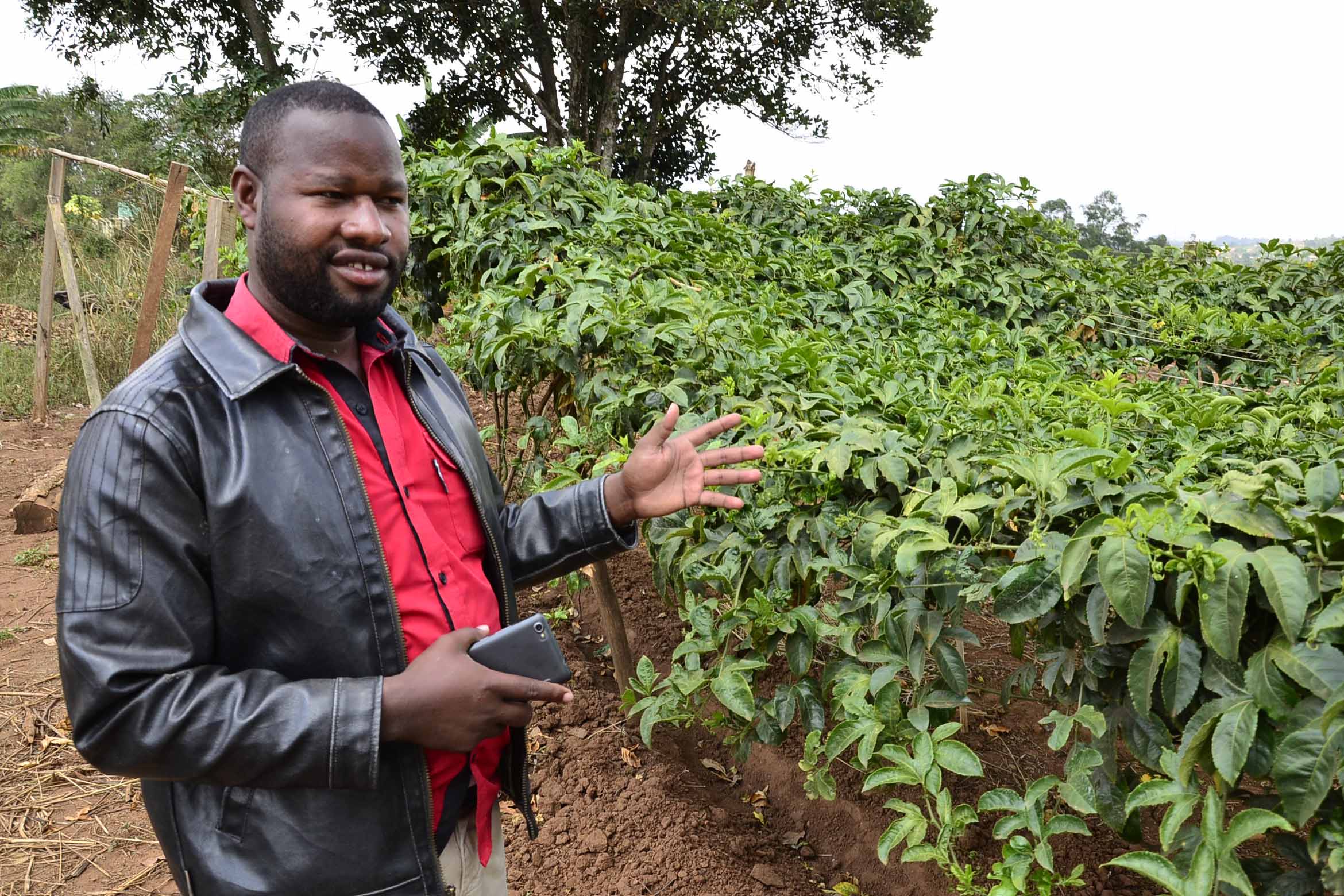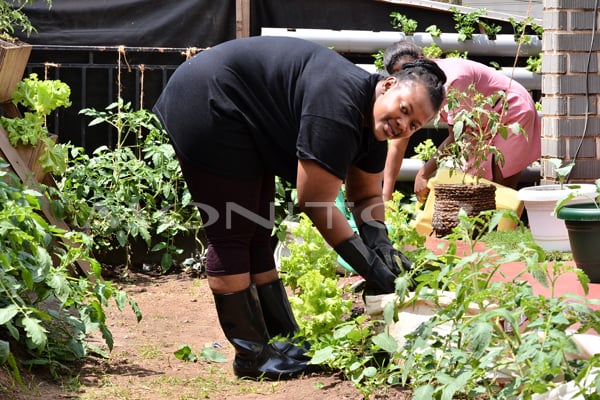Prime
How to establish a passion fruit vineyard this season

Agronomist Julius Ahagaana explains how one can establish a passionfruit vinesyard. Photo/File
What you need to know:
- Regularly observe your vines for aphids or worms, wilting of leaves or any spots/ holes on the leaves. Spray if you note any of these threats. Keep pruning your vines, removing the suckers and maintain only one or two stems to promote rapid vertical growth.
Prepare a raised seedbed of not more than three feet wide. Ensure the rows run from east to west or vis versa because this shields the plants from direct sunlight and windy rain.
Apply NPK fertiliser when planting. The passion fruits should sprout within 14 to 21 days.
At this stage thin them and if possible put each stem into individual planting bags, which reduces labour costs. After one week, apply CAN fertiliser to promote growth only if slow growth is observed. The vines take 40 days to reach a height of 4-6 inches and this is when to transplant them to the open field
Transplanting
At the time of transplanting put one tin of manure a foot from the plant. It should be dug it into the soil on the upper side of the plant so that when it rains, the nutrients flow towards it and not away from it. Always note the slope of your land and learn how your water flows when it rains to ensure nutrients are never lost.
Rows
In the field, the distance from one row to the other should be two metres while the distance from one plant to the next should be three metres.
The rows should be prepared from east to west. Planting north to south makes the vines act as wind breakers and you are likely to find them down due to strong winds.
When planted east to west, the wind passes in between the rows without interfering with the vines.
Planting vines
Plant the vines in holes two feet wide by 1 ½ feet deep. About one foot from the vine, prepare another hole to hold the supporting post so that the vine will fasten itself to it as it grows. The post should be 8 ½ ft long. Some 2 ½ ft should be in the ground, leaving 6 ½ ft above.
Run a barbed or smooth wire on the top of the posts, fastening it securely. These posts and wires will provide the much-needed support for the passion fruit vine, which grows to over 10 feet in length and weighs between 10-20kg at maturity.
Transplanting
At the time of transplanting put one tin of manure a foot from the plant. It should be dug it into the soil on the upper side of the plant so that when it rains, the nutrients flow towards it and not away from it. Always note the slope of your land and learn how your water flows when it rains to ensure nutrients are never lost.
Pruning
Regularly observe your vines for aphids or worms, wilting of leaves or any spots/ holes on the leaves. Spray if you note any of these threats. Keep pruning your vines, removing the suckers and maintain only one or two stems to promote rapid vertical growth. However, stop when they reach the top of the post and start spreading to the wire as the new suckers are now needed to increase fruit production.
Flowering
In about four months, the vines should start flowering. At this stage, it is crucial that you spray an insecticide to prevent any insects laying their eggs on the flowers, which is where the fruit will emerge from. It is also at this point that you add another two tins of manure to each plant to provide extra nutrients needed at the crucial stage of fruit formation. Observe the slope and incorporate the manure at the top, a foot from the vine
Be careful about the chemicals you use and only spray if you see a threat. Unnecessary spraying may result in your fruit being rejected if the chemical levels exceed the internationally approved limits. Avoid insecticides and fungicides classified as poisonous.
The vines grow long and care should be taken to ensure they do not reach the ground. Prune/cut the bottom vines always maintaining a distance of one foot from the ground. This reduces the transfer of diseases from the soil to the vines, especially when it rains.
Harvesting of passion fruit
When the fruit is being harvested, spraying should not take place at all. On average expect to harvest one kilogramme of fruit from each vine but the level of care you give your vine directly affects this. When well- maintained, some of the vines can produce 2-3kg of fruit per week.
The vine will produce fruit for four to five years at which point many farmers will uproot the old ones. By then you should have prepared the new crop to ensure constant production.
In addition, rotate the crop and plant the second in a different area to control pests and diseases.
Harvest the fruit on the day of transportation to ensure it gets to the market when extremely fresh. The ready fruit appears light green with a slightly yellow tinge. Only harvest what is ready to avoid the fruit developing a sour taste.
Pest and diseases that affect passion fruits
Use clean planting materials and copper-based fungicide sprays during the cold/rainy season. Field hygiene is recommended. Use of bio-pesticides is encouraged for the requisite Maximum Residue Limit (MRL) incidence. Integrated pest management techniques such as orchard sanitation and physical control using insecticide-treated nets and sleeves, are also encouraged.
When transplanting, drench the hole with Trichoderma at a recommended rate of 1 ml/lt of water. There are a number of pests such as insects, and nematodes and diseases that affect passion fruit. Thrips, phytophthora blight, and brown spots are the major pests and diseases of the fruit.
Pests feed on the plants, sucking sap from the growing tips or from developing fruits. Bug attack (by both nymphs and adults) is sporadic and coincides with warm weather.
Nematodes can cause severe problems in passion fruit, but only in the purple varieties, as the yellow ones are completely resistant.
However, there is a need to expand the area under passion cultivation to meet the increasing demand. The increasing pest pressure provides a prospective business venture for agrochemical companies to invest in.
Passion fruit woodiness potyvirus (pwv)
This is an important disease of passion fruit that is transmitted by aphids. Its symptoms include distortion of leaves and woodiness of fruits.
Plants are stunted, yields are reduced and vines die. It also causes yellow spots, flecks or mottling on leaves. There is currently no treatment of woodiness virus.
However, a number of cultural practices can help to mitigate the impact of the disease. They are as follows:
Seedlings: Produce and plant virus-free seedlings; Eliminate old and abandoned orchards before the start of production; Seedlings: Produce and plant virus-free seedlings;
Infected vines: Cut out infected vines and replace them. Pick up and dispose of any fallen fruit from your passion plant or other fruit trees.
Pruning practices: Pruning tools can spread viruses. Use hand pruning to check spread of virus and when using tools disinfect them with bleach
Weeds: Keep weed-free to remove hosts of the virus.
Chemical control is inappropriate. Although there are insecticides to kill aphids, they are not effective in stopping the spread of viruses, because it is so rapid.
Use of Neem oil: According to a 2015 Brazilian research, The Neem Oil in Passion Fruit Management by Rafael Mattos Deus and Aloísio Costa Sampaio, this has great potential to control the incidence of viruses in passion fruit because it repels the vector insect. There is a lower incidence of the symptoms of the virus in treated plants.
Brown spot (alternaria passiflora)
This is the most important disease of passion fruit favoured by warm and moist weather. It attacks leaves and fruits, causing brown rings with dead spots. On leaves, small brown spots appear first.
These enlarge, develop a lighter-coloured central area, and become irregular or angular in shape. Apply Bacillus subtillis to control brown spots at vegetative stages and at 1ml/lt of water.
Septoria spot
Caused by the fungus Septoria passiflorae, this disease attacks leaves, stems and fruit. Even a light infection results in defoliation and premature fall and loss of fruit.
Leaves have tiny superficial, irregular, light-brown spots that appear quickly followed by severe defoliation.



